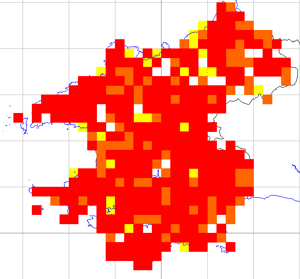Swallow - 2003-07
 Thursday, May 10, 2012 at 9:05PM
Thursday, May 10, 2012 at 9:05PM Swallows are highly dependent on the availability of suitable buildings for nest sites. They nest in barns and other outbuildings, porches, sheds and garages, and are often semi-colonial particularly in farm buildings where livestock are kept. More unusual nest sites have included a sea cave in Martins Haven and a disused underground heating duct at Stackpole. They have nested in the public conveniences at Martins Haven for many years. Swallows have also bred successfully in some of the rooms in Carew Castle. Swallows are aerial insect feeders, and forage over a range of semi-natural habitats such as freshwater and salt marsh; open water; open, wooded areas and scrub, and over pasture especially if it is grazed by livestock, e.g. cattle and horses.
Data obtained during the 2003-07 tetrad survey suggests relatively little change in the distribution of breeding pairs of Swallows in the county (see map).
The data show an increase of 13% in the number of tetrads where breeding was confirmed between the two tetrad surveys. The map shows a largely unchanged distribution of tetrads in which breeding was confirmed or probable. A few gaps have however, opened up, for example on the St David’s Peninsula, on the Pencaer Peninsula and in one or two parts of mid and north Pembrokeshire away from the coast. These appear to be quite small-scale, localised losses that may be linked to the loss of suitable nest sites, e.g. as a result of conversion of outbuildings to dwellings. They may also be a result of changes in the distribution and abundance of aerial insects, following changes in land management practices.
Following the 1984-88 tetrad survey, it was estimated that at an average density of 20 pairs per tetrad, there were at least 8,500 pairs of Swallows in the county. A 13% increase in the number of tetrads where breeding was confirmed during the 2003-07 tetrad survey suggests that the breeding population is around 10,000 pairs.
Jane Hodges

Fieldwork 2003-07 (based on 490 tetrads)
Red = breeding confirmed = 338
Orange = breeding probable = 74
Yellow = breeding possible = 22
Total tetrads in which registered = 434 (88.6%)
 JEH,
JEH,  PBBA 2003-7 in
PBBA 2003-7 in  Swallow
Swallow 

Reader Comments